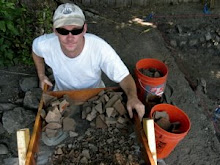The buildings that burned were the Carpenter Shop and it's Lumber Shed. The smelter blog included pictures taken of these two buildings before the fire, along with a description of their history:
 |
| The Quincy Smelter's Carpenter Shop and Lumber Shed from the blog: http://quincysmelter.wordpress.com |
More photographs and text about the support buildings were posted by the Copper Country Explorer:
http://www.coppercountryexplorer.com/2009/12/the-support-buildings-p1/
The fire started at about 11 pm on Saturday night. Due to it's location on the water in Ripley, the fire was visible from all over downtown Houghton. Here is the "stub" story in the Mining Gazette:
 |
| The Daily Mining Gazette's photo in their coverage of the fire. |
Photos of the event are finding their way to media sites like Flickr.com.
This morning I went down to see the damage. I am very grateful to the firefighters for working so hard to save the Stock House, which was scorched by the heat, and the other buildings in the immediate vicinity of the Carpenter Shop. Here are some pictures from my cell phone camera of the ruined buildings this afternoon:





